![]()
![]()
![]()
Use LEFT and RIGHT arrow keys to navigate between flashcards;
Use UP and DOWN arrow keys to flip the card;
H to show hint;
A reads text to speech;
70 Cards in this Set
- Front
- Back
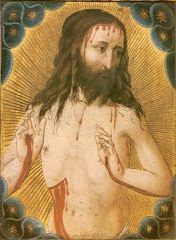
Hans Pleydenwurff, Man of Sorrows, oil on panel, c. 1456.
|
❦ The anxiety of reformers came from images like this. & the unregulated use of images, unorthodox images, church authorities felt threatened by local mystics and the cult of the saints, selling of indulgences by Rome and the connections of images to this practice.
❦ Man of Sorrows iconography stems from the mystical vision of St. Gregory, who doubted the trans-substantiation. Christ of the passion peering over to his donor.. |
|
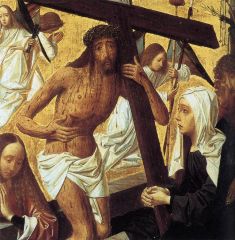
Geertgen tot Sint Jans, Man of Sorrows, oil on panel, c. 1480-85.
|
❦ Highly decorative injuries on Christ, angels holding elements of the passion The Virgin, Magdalene, and St. John the Evangelist. Space of images seemed cropped but it is designed to be this way to put Christ into our space.
❦ Glaring yellow background, not in realistic space. Possibly the door of a tabernacle, hinges. ❦ Lay movements starting to focus on the suffering of Christ. Lay movements starting in 1380 in the low countries, imitation of Christ, based on 3 circulating texts, creates Devotio Moderna. Gerard Groote: laypreacher, criticizes the church, mobilizes people. "Rise of the Leity" supports personal relationship with Christ, using the life and passion of Christ as a model for living. Starts trying to make scripture available in the vernacular. Austere religious exercises, personal improvement, service and dedication to other. |
|
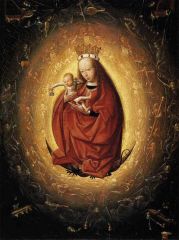
Geergten tot Sint Jans, Madonna of the Rosary, oil on panel, c. 1480.
|
❦ Roughly an image of the apocalyptic madonna, on a crescent moon."little egg shaped form."
❦ Very otherworldly. Little angels surrounding her with instruments of the passion and musical instruments. multi-sensory experience. Christ is ringing 2 little bells. ❦ Reference Petrus Christus Madonna of the Dry Tree. Also made for a confraternity. Not based in scripture. Highly imaginative. |
|

Hans Memling, Shrine of St. Ursula, painted gilded oak, 1489.
|
❦ Painted gilded oak. Painted panels depict the life of St. Ursula.
❦ The Golden Legend attempts to anthologize the lives of the saints. Painters are fleshing out the exact iconography for the best depicting them. ❦ Ursula and the 11,000 virgins. Bones found in Cologne that were supposedly theirs.. |
|
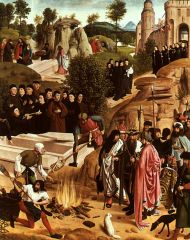
Geertgen tot Sint Jans, Burning of the Bones of St. John the Baptist, oil on panel, after 1484.
|
❦ Commissioned by the Knights of St. John. A prior was coming from Malta, Geertgen tot Sint Jans commissioned to paint this for the event.
❦ Knights we able to salvage a leg bone and a finger bone of the Baptist. Knights of Harlmen posing as the original knights, members of the Confraternity are portraits. |
|
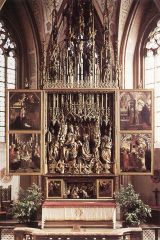
Michael Pacher, St Wolfgang Altar, 1471-81.
|
❦ Northern Italy, Austria; Southern part of the alps. Pacher build the altar, sculpted figures, and painted panels. Typical "renaissance man." Huge altar. Retable: has transformations, can open and close several ways, interactive.
❦ Life of Christ, life of the Virgin, crucifixion, adoration of the virgin, and life of St. Wolfgang. Closed altar shows his life; 10th c. bishop. ❦ Borrows northern style, but also blends northern italian ideals too. Low horizon line, tilting perspective, etc. Christ raising Lazarus shows hints of his travels to Padua and familiarity with Mantegna. |
|
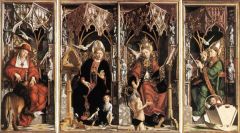
Michael Pacher, Alterpiece of the Church Fathers, oil on panel, 1483-4.
|
❦ Depicts St. Jerome, St. Augustine, St. Gregory, St. Ambrose. St. Sigisbertus: all identified by the little anecdotal experiences of their life.
❦ St. Jerome: takes thorn out of lion's paw, St. Augustine: little boy and spoon on beach, St. Gregory: raised the soul of Trajan, baptized him and sent him on to salvation. St. Ambrose: small child. St. Sigisbertus: local saint, received the heart of St. Augustine. |
|

Michael Pacher, Alterpiece of the Church Fathers, oil on panel, 1483-4. Detail: Angel Offering St. Sigisbertus the Heart of St. Augustine.
|
❦ St. Sigisbertus: local saint, received the heart of St. Augustine.
|
|
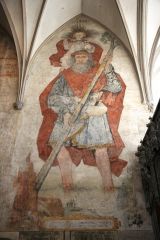
Ulrich Apt (?), St. Christopher, Augsburg Cathedral, fresco, 1491.
|
❦ Augsberg Cathedral, fresco. Painted on back wall, if you saw a representation of St. Christopher that day you would die an unredeemed death.
|
|
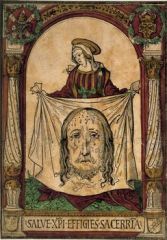
Hans Burgkmair, St. Veronica with Sudarium, woodcut, 1505.
|
❦ Burgkmair has classical training- hence, columns. Christ's face is huge and central. Veronica's handkerchief has taken on a new quality. Colored print, "fancied up."
|
|

Virgin with Crown and Scepter on a Crescent, Anon. German. woodcut, 1460.
|
❦ Making these prints expanded devotional audience. Largely produced in monastic community and devoted to saint or local saint or cult images. First instances around 1410, usually a miraculous event or of the scene of a shrine etc. "souvenirs"
❦ Images like these were also the locus of indulgences as well. Guaranteed the remission of time in purgatory. Inflation of "years" that an images would remiss. ❦ Basic and simple design based on lines and contour. |
|

Anon. Bavarian master, St. Christopher of Buxheim, woodcut, 1423.
|
❦ Simple images like this were used for educating the illiterate and giving illustrations for religious texts, trigger pious emotions, commit these images to memory.
❦ Uses of images approved by Thomas Aquinas. Idolatrous emotions not allowed. This image is associated with Carthugan monasteries. ❦ Landscape rises very high into the sky, scale isn't mathematical, but rather symbolic. Being used Talismanically. Reformers don't like this. |
|

St. Dorothy, Anon. German, woodcut, 1410.
|
❦ Shows decorative elements of printing. While it serves a very strict purpose it is also a place for experimenting with graphic vocabulary. Linear element of the flowering tree.
|
|
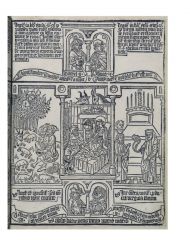
Anon., Birth of the Virgin from the Biblia Pauperum (Pauper’s Bible), Germany and Netherlands, woodcut, 1450.
|
❦ Text and images both carved into blocks. Not particularly efficient for printing. "Biblia Pauperum" religious manual for clergy. Primarily visual, pneumonic aid. New testament scene and two old testament scenes that relate to it. A type of altarpiece-esque design. Birth of Virgin, Annunciation.
|
|

Anon., Annunciation from the Biblia Pauperum (Pauper’s Bible), Germany and Netherlands, woodcut, 1450.
|
❦ Text and images both carved into blocks. Not particularly efficient for printing. "Biblia Pauperum" religious manual for clergy. Primarily visual, pneumonic aid. New testament scene and two old testament scenes that relate to it. A type of altarpiece-esque design. Birth of Virgin, Annunciation.
|
|

Anon., Triumph Over all Temptations from the Ars Moriendi (The Art of Dying), woodcut, Netherlands, 1450.
|
❦ Used to help the laity prepare for dying, and to help young clergy minister to the sick and dying. Confrontation of virtues and vices. Sick person being turned by vices: Despair, Lust, Pride, Avarice, Impatience. Overcome by; Faith, Hope, Love, Humility, Detachment. Demon helps him kick over table, kicks doctor in back. Triumph over temptation very visual, very didactic.
|
|

Wolgemut & Pleydenwurff, Fall of Man and the Expulsion, Nuremberg Chronicle, 1493.
|
❦ Produced in the print shop of Anton Koberger, author: Schedel. Huge, most profusely illustrated books of its time. Young Albrecht Durer working in the shop as well. Religious history, maps, etc. Some 1100 illustrations from 650 woodblocks. Fall of man and the expulsion: Continuous narrative. Visual precedents tree from south africa. Specificity of design. Monstrous races.. Marvels of the east. Images blocks framing text. Taxonomies the "other."
|
|

Wolgemut & Pleydenwurff, Monstrous Races from Schedel’s Nuremberg Chronicle, 1492-3.
|
❦ Produced in the print shop of Anton Koberger, author: Schedel. Huge, most profusely illustrated books of its time. Young Albrecht Durer working in the shop as well. Religious history, maps, etc. Some 1100 illustrations from 650 woodblocks. Fall of man and the expulsion: Continuous narrative. Visual precedents tree from south africa. Specificity of design. Monstrous races.. Marvels of the east. Images blocks framing text. Taxonomies the "other."
|
|

Michael Pacher, Interior St Wolfgang Altar, 1471-81.
|
❦ Continuity between painted and sculpted figures in the altar. Background very dark, foregrounds painted to catch the light: high contrast, deep undercutting, florid tracery characterize both his painting and sculpture.
|
|

Donatello, The Penitent Magdalen, polychrome wood, 1453-55.
|
❦ Wood/polychrome sculpture. Depicts and unorthodox version of magdalene iconography that took hold in the south and was also interpreted by german artists. "Hairy Mary" hermetic lifestyle, hairshirt. "Magdalene": talmudic etymology, curling of the hair, reference to prostitution. Matted hair. Naturalistic. Penitent.
|
|

Hans Multcher, Assumption of the Magdalene, polychromed limewood, 1435.
|
❦ Beautiful, fresh, mary wearing a sort of hair "suit" stylistic and patterned rather than naturalistic. Part of an altar.
|
|

Tilman Riemenschneider, Ascension of the Magdalene with angels, Münnerstadt Altarpiece, limewood, 1490.
|
❦ Depicts the unorthodox "hairy" Mary Magdalene iconography. Body has become completely covered by hair. Overly decorative, patterned, "florid." Detracts from the meaningful connotations of penitence?
❦ Part of the Munnerstadt altarpiece, dedicated to the life of the Magdalene. Hair is a significant element of the story. Relief side panels of Mary anointing Christ's feet and the scene resurrection. Focused on highly patterned surfaces, details, faces, etc. Low relief shows proximity to woodcuts but also shows the painterly education that would be applied even to woodblock cutting etc. Thinks of himself as a 2-D artist. ❦ Munnerstadt: Retable altar (Retrotablerium: behind the altar) central panel devoted to the life of the saint. These altars would be comissioned for a family or confraternity. Educated illiterate, spur pious emotions memory of the saint. Actual idol worship of the objects was not allowed. Texts starting to circulate about the difference between worship paid to the images and worship paid to the prototype. Colere: Honor the saint. Adorare: to the image. |
|

Tilman Riemenschneider, Altar of the Holy Blood, glass, limewood, 1499-1505.
|
❦ Functioned as a reliquary for the relic of a drop of Christ's blood. Interested in establishing this church as a major pilgrimage site.
❦ Main scene is of the last supper, because it mirrors the act of transsubstantiation. Explains the mystery of the host. Focuses on the betrayal of Judas. Figures in scene asking themselves "who" will betray Christ. Exploration of expression. Deeply drilled hair, highly individualized faces. |
|

Veit Stoss, Virgin of the Rosary, St. Lorenz, Nuremberg, polychrome limewood, 1517.
|
❦ Works in Krakow, returns to Nuremburg. The altarpiece is at St. Lorenz. This work hangs in the nave. Patronized/commissioned by the family of a famous brewery, patricians. Sculpture in the round, just used conventions of altarpiece carving. Lifelike..
|
|

Adam Kraft, self-portrait, detail from 60 ft. sacrament tower, sandstone, 1493.
|
❦ Supports the bottom of the 60 ft sacrament tower. Himself and two assistants. Portrayed as craftsmen. The greater the skill the greater the distraction from devotion? Too naturalistic for it's own good. Many such artworks were destroyed.
|
|

Erhard Schoen, Complaint of the Persecuted Images, woodcut broadsheet, Nuremberg: 1530.
|
❦ Woodcut broadsheet that explains the feelings of the images about being destroyed. Shows that sculptures were really contested during reformation debate.
|
|

Master ES, Martyrdom of St. Sebastian, engraving, 1470.
|
❦ Engravings fill in the adjective. Making commercially secure subjects, borrowing images from early woodcuts. Subject matter in engraving is less devotional, more descriptive, and artistic. Engraving is still a linear process. Hatching, more definition. St. Sebastian is now in a landscape, Master ES fully fleshes out the story.
|
|
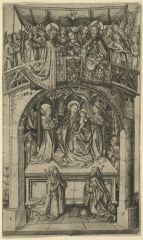
Master ES, Large Einsiedeln Madonna, engraving, 1466.
|
❦ Still making financially secure works, imagery that had religious function or meaning. This is a print to sell to pilgrims who visited the monastery as an indulgence. Master ES's madonna and chapel do not actually resemble anything that a pilgrim would have actually seen developing a graphic vocabulary. Hatching, stippling, modeling for masonry, robes, florals etc.
|
|

Master ES, Grotesque letter N from the Fantastic Alphabet, engraving 1465.
|
❦ Inspired by manuscript illumination marginalia. Composite of monks, nuns, and jesters. Interaction of grotesque characters.
|
|

Master ES, St. John on Patmos, engraving, c. 1460.
|
❦ Building composition in levels. Shows St. John having revelation visions. Little clumps of cabbages... composition spills out from the center. Very patterned surfaces.
|
|

Housebook Master, Obscene Garden of Love, drypoint, 1480.
|
❦ Copying from Master E.S. version drypoint, 1460.? No regulations on copying artist would jsut take the idea if they liked it. Hanfcolored. Wokred in Rhine reigon. Patronized by humanist and aristocratic people. Tin or Lead plate.
|
|
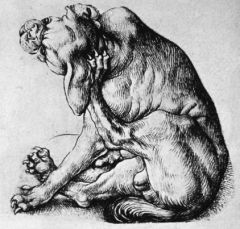
Housebook Master, Dog scratching himself, drypoint, 1475.
|
❦ Akin to a sketch or study from life. Velvety burr visible. Modeling done by hatching of varying density. Art from observed life, not a set religious scene. Would not have been mass produced or sold.
|
|

Martin Schongauer, Procession to Calvary, engraving, 1470.
|
❦ Borrowing from Vander Weyden's sense of composition. Spears and lances and whips serve as functional, dynamic qualities. Right side is bright, overexposed. Clouds coming towards Calvary. Modeling in the same way painters do. Variey of textures in hatching used to model. Whirlpool around Christ. Thinking about torment and agony, brings a variety of emotions.
|
|

Martin Schongauer, Temptation of St. Anthony, engraving 1470-75.
|
❦ Pientre-graveur. Religious but still fun. Copied by a lot of people. Hermit, egyptian. Inventing gruesome individualized monsters. Engraving w/ a painterly sensibility. More than tone but texture and "color."
|
|
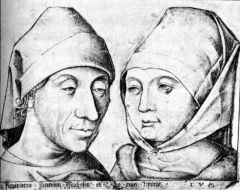
Israhel van Meckenem, Self-portrait with wife Ida, engraving, 1485-90.
|
❦ Pientre-graveur. Self conscious artists not craftsmen, but aware as their work of art and themselves as "real artists." experimentalism. subject-less art. secular, not tied to religious/ready market. honest portrait of self and wife, everyday clothes etc.
|
|

Israhel van Meckenem, Juggler and the Woman, engraving, 1490.
|
❦ Pientre-graveur. Market-less print. If is was about love, there would be more courtly style. Bandarels, ribbons. Strange subject.. messy jester, uninterested woman.
|
|

Israhel van Meckenem, Dance at the Court of Herod, engraving, 1500.
|
❦ Pientre-graveur. Strange view of a commonly depicted moment. Focus is not on the dance of Salome, or even John the Baptist. More interested in dance floor, courtly love, courtly ritual, courtly behavior. Religious story doesn't get the attention, common things do.
|
|

Mathis Gothart Neithart (called Grünewald), Isenheim Altar, oil on 9 panels, 1515.
|
❦ Saint Anthony was the patron saint of butchers and sausage makers, and of domesticated animals? pigs? and basketweavers.. and plague victims.. This altar was commissioned by a Confraternity in Isenheim that specialized in hospital work and skin diseases.
|
|

Mathis Gothart Grünewald, Isenheim Altar, 1515.
OPEN POSITION |
❦ The open position (for feast days) of the altarpiece depicts: Middle panel- St. Anthony Enthroned between Sts. Augustine and Jerome, Left panel- Temptation of St. Paul, Right panel- Temptation of St. Anthony.
❦ Left panel- Temptation of Saint Paul. St. Paul meeting with St. Anthony. "original monastic." Swampy setting. Palm frond and hair shirt. Bird bring two loaves of bread. ❦ Right panel- Temptation of Saint Anthony. Scary monsters a la Schongauer, very detailed and individualized. Great drama. Human like creature in lower left, decomposing skin and pustules, stealing bible. The creature represents ergotism; "St. Anthony's" fire. A skin disease that causes similar looking symptoms. Members of the confraternity took care of people with plague and ergotism. |
|

Mathis Gothart Grünewald, Isenheim Altar, 1515.
CLOSED POSITION |
❦ The closed position (daily, nonliturgical view) depicts: Left panel- St.Sebastian, Right panel- St. Anthony, Center panel- Crucifixion, Predella- Christ at the Tomb.
❦ Center panel- very grotesque crucifixion scene. Shows the trend towards extreme, active suffering, mystical devotion. Scale is all wacky. John the evangelist and the Virgin, Magdalene and John the Baptist. "He must grow while I must shrink." Night scene, heightened reactions from viewer. Distended, contorted bodies. Not important that figures are in proportion. Italian Renaissance standards not in play here. Emphasis of mystical texts on artists. Direct link to St. Bridget. Sacred horror, visceral, personal. No stylistic unity, very theatrical. ❦ Left panel- St. Sebastian, much more classically rendered, solemn, column. |
|

Mathis Gothart Grünewald, Isenheim Altar, 1515.
MIDDLE POSITION |
❦ The middle position (sunday view) depicts: Left panel- Annunciation, Center panel- Angel Concert and Nativity, Right panel- Resurrection.
❦ Predella: Christ at the tomb. Not stylistically continuous. Also, proportions are all off. Models for grief and compassion. ❦ Left panel: Annunciation. Takes place in a sort of gothic interior. Angel Gabriel comes in to announce the birth of Christ. Drapery, light. Bright primary colors. Liturgical drama. ❦ Central panel- incarnation, angel concert, nativity. Holds Christ in a tattered cloth reminiscent of crucifixion. God the father, in bright light, pure color, indefinite form. Virgin Mary dematerialized by light, same handling as God the father. Refers to the Virgin as she existed in the mind of God, before time. Heavenly angel choir, Bosch like. Seraphim playing cello? NOPE– Lucifer.. ❦ Right panel- Resurrection. Body is free of wounds. Dematerialized. So light in comparison to other representations where he is so heavy. Free of the flesh. |
|

Vespucci broadsheet with Brazilian Tupinambas (Augsburg, Germany: Johann Froschauer, 1505)
|
❦ Attempts to summarize 8 page pamphlet into one images with caption. "New World Other." Hand colored. Stenciling used to expedite process but sometimes the lines aren't completely filled in. Peoples that Vespucci encountered on third voyage over- Brazillian Tupinambas. Feather skirt, feather cape, feather headdress and anklets. Precious stones applied to face and chest. References to cannibalism. Kissing mothering, feeding: essentialized view of these people's lives. Germany: these prints circulated because it was not state secrets, more ethnographic view of peoples.
|
|
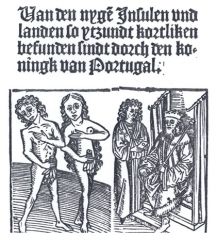
Vespucci, Van den nyge[n] Insulen und landen (Magdeburg, Germany: Jacob Winter, 1506) woodcut pamphlet.
|
❦ "New Islands and Lands." Image spliced together from two separate blocks. The Portuguese King and Vespucci are re-purposed images of King Solomon and attendant. New peoples are re-purposed images of Adam and Eve. Reusing common images for convenience and recognizability.
|
|
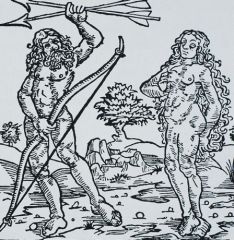
Vespucci, frontispiece to Mundus Novus (Rostock, Germany: Hermann Barkhusen, 1505)
|
❦ Circulated in Latin for learned humanistic audiences, and in vernacular for common folks. This images made specifically for pamphlet, but drawing on images of Adam and Eve/ the wild man and woman. Nude, belligerent, unashamed, aggressive. "Language" of print evolving.
|
|

Hans Burgkmair, Peoples of Africa and India, woodcut frieze, 1508.
|
❦ Setting apart "peoples new to europe" - not everyone is a Brazilian tumpinamaba. Showing more diversity, travel report of the journey. Artist turns the report of what the peoples looked like. Guinea and african coast. Very accurate to the people. Maybe actually seen in person or by sketches? Not generalized or borrowing from other conventions. Specify and locate geographically. Very large frieze. Market scene, camps, animals, india.
|
|

Hans Burgkmair, In Allago, woodcut, 1509.
|
❦ Independent print of peoples of cape of africa. Compare to Albrecht Durers fall of man. Inspired?
|
|

Hans Burgkmair, Virgin and Child with a Round Arch, hand-colored woodcut, 1508.
|
❦ Hand colored woodcut. Innovation in printing. Thinking of medium more than just for circulation. Small devotional panel- resemblance. More valuable/expensive. Chiaroscuro woodcuts mimics, carta azzurra: blue card. His is hand colored?
|
|

Hans Burgkmair, Maximilian I, chiaroscuro woodcut from two blocks on red tinted paper, 1508.
|
❦ Borrows from italian technique of carta azzura. Used tinted paper to give you a middle ground- blacks give shadow, white gives gives highlights. Attempts to imitate this technique by printing w/ multiple blocks: line block, 1 or more (usually 2) tone blocks, sometimes white is done with gold. Tries to raise status of woodblock as a work of art. Maximillian as a patron of print. "Caesar" and imperial ambitions.
|
|

Hans Burgkmair, St. George and the Dragon, chiaroscuro woodcut, 1508.
|
❦ Borrows from italian technique of carta azzura. Used tinted paper to give you a middle ground- blacks give shadow, white gives gives highlights. Attempts to imitate this technique by printing w/ multiple blocks: line block, 1 or more (usually 2) tone blocks, sometimes white is done with gold. Tries to raise status of woodblock as a work of art. Maximillian as a patron of print. "Caesar" and imperial ambitions.
❦ Not as successful, gets too complicated. Maximillian claims kinship to St. George. |
|

Marcantonio Raimondi, Judgment of Paris, engraving, c. 1520.
|
❦ Master of reproductive prints, commonly Rapheal. Group of river gods. Breu borrows information about composition also borrowed by Manet for Dejuner: 1863.
|
|

Jörg Breu, Murder of Agamemnon, pen and ink, 1525.
|
❦ Design or a painted glass roundl. Again borrows from Raimondi's composition. "Homegrown classicism." Show how print borrows to circulate information.
|
|

Andrea Mantegna, Battle of the Sea Gods, engraving, 1470.
|
❦ Durer saw this when he was travelling in Italy. Made a copy of his own. Looking to works of antiquity for interesting compositions and treatment of the human body.
|
|

Dürer, Battle of the Sea Gods (pen & ink after Mantegna engraving), 1494.
|
❦ Relying on works of antiquity, and works like Mantegna's to tell him how to interpret the human form. Durer models with hatching, show his attention to print mentality. Contropposto and Chairoscuro "buzzwords." Vetruvius, humanists, translating and propagating texts at this time.
|
|
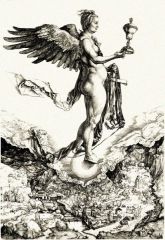
Dürer, Nemesis (the Great Fortune), engraving, 1501-2.
|
❦ Classical literature tradition. Shows Durer's twin concerns with attention to proportions and to naturalism. Vetruvian proportions at work in this body- formulaic approaching to composing a human body.
|
|

Dürer, Adam and Eve, engraving, 1504.
|
❦ Vetruvian proportions help to deal with ideas of movement and foreshortening. Presumes a new kind of viewer. Models are Apollo Belvedere and Medici Venus. Previous iconography calls for shame, covering, and cries of pain. This is not that same Adam and Eve. "Pre-lapsarian" : before the fall. Contrapposto and Chiaroscuro. Interesting compositional choices to cover their bodies. Mountain ash tree covering Adam and fig leaf (from an apple/fig hybrid tree) covering Eve. Hair has the drilled look of classical sculpture. So many different layers of light built in. His observation of nature extends to the animals as well, they function as characters. "Parents of humanity interacting with nature." Mountain goat is commentary on "climax." Balance of humors important in medieval thought. Sanguine, rabbit, perky and alert. Phlegmatic, ox, sluggish and full of phlegm. Choleric, cat. Melancholy, elk. Very densely packed works but also beautiful and playful.
|
|

Dürer, Mill in a Meadow, water color & gouache, 1495-7.
|
❦ Independent studies of nature. Views of the world around him. No demand for something like this evidence of Durer training himself. No obvious subject matter. Well before landscapes were considered independent art. empirical study of the natural and atmospheric qualities.
|
|

Dürer, Mill and landscape (Wire drawing mill), water color & gouache, 1494.
|
❦ Independent studies of nature. Views of the world around him. No demand for something like this evidence of Durer training himself. No obvious subject matter. Well before landscapes were considered independent art. empirical study of the natural and atmospheric qualities.
|
|

Dürer, The Great Piece of Turf, water color & gouache on paper, 1503.
|
❦ Durer is keenly observing the world around him. Very monochromatic palette, but very individualized, observed in nature.
|
|

Dürer, Rabbit, watercolor, 1502.
|
❦ Extreme amount of attention to detail. Shows Durers interest in representing every detail. All God's creatures get the same attention.
|
|

Dürer, Monstrous Sow of Landser, engraving, 1496-7.
|
❦ Siamese pig born in Landser. Sign of coming apocalypse? Even though he didn't observe this in nature, he always makes it seem like he did.
|
|

Dürer, Rhinoceros, woodcut, 1515.
|
❦ Published as a news broadsheet. Indian King to King of Portugal. Marvelous beast, unheard of in Europe until this point. Never saw the animal, just saw sketches. Textual and visual description.
|
|

Dürer, Artist using a Perspective Grid, from the Unterweisung (Treatise on Measurement), woodcut, 1527.
|
❦ From treatise on measurement. Trying to record techniques to help others.
|
|

Dürer, Artist drawing a Lute, woodcut, 1515.
|
❦ From treatise on measurement. Trying to record techniques to help others.
|
|

Dürer, Studies on the Proportions of the Male & Female Body, woodcut, 1528.
|
❦ From treatise on measurement. Trying to record techniques to help others. Leonardo/Vetruvius. Ratio of parts: Trumlein. 26 ideal sets of bodies.
|
|

Dürer, St. Jerome, frontispiece to Epistolae, woodcut, 1492.
|
❦ Early church father, monk, cardinal, roman. Removes thorn from Lion's foot. Early work of Durer's and somewhat expediently produced. Don't see the typical level of detail. Relying on typical iconography of Jerome.
❦ Volgate: translation of the bible into Latin 4th c. Also relying on Flemish conventions of showing an interior space. Symbolism in common objects. Probably had scholarly scholarly advisor for early works. |
|

Dürer, St. Jerome, engraving, 1514.
|
❦ Detail, shading, light, chairoscuro. Very attentive to detail, much more "Durer-esque." Jerome was a model for humanist scholars. Humanists were essentially secular monks: had lay religious affiliations, all schooled in classical languages. Contemporary editors and translators of religious texts. Departing from the removed tradition of manuscript making. Fashioned themselves after images of the "prototypical" scholar.
❦ Lion is like an oversized housecat. Durer uses cues from italian perspective study to render their depiction, seems to zoom into Jerome. Memento mori, crucifix, cardinal cap, glow that surrounds his head. Light from the window: worldly. Light around Jerome: otherworldly. Scholarly gravitas, divinely inspired. This piece stands alone as a work of art- Durer as the pientre graveur. Compare to early version.. |
|

Dürer, Erasmus of Rotterdam, engraving, 1526.
|
❦ Always seeking out portraiture, never satisfied. Part of Erasmus' self fashioning as scholar modeled after St. Jerome. Had many portraits made and wanted them to be contemporary. Humanism has chicken and egg relationship with printing press. Manuscript making in monastic centers, port centers, urban center. Presses take over the business aspects and areas that have presses become centers of ecclesiastical and urban thought. Basel- primary printer Erasmus was involved with.
❦ Updating Jerome for a modern audience, and therefore takes over his persona. A portrait is more than just a fidelity to the look of the face, this portrait takes great pains to align himself with the conventions of St. Jerome. See the weight of his labors. "The better image will his writing show." Durer's modesty? Or Erasmus? PR program announcing the presence of printing as well. "republic of letters" Erasmus on staff as in courtly situation. Needs to self promote. Durer is arguably the greatest artist on the continent in this period. Erasmus' most famous work "In Praise of Folly" 1511, criticism of religious and lay life. |
|

Dürer, Angels with Sudarium, engraving, 1513.
|
❦ Sudarium, "verra icon." idea lines up perfectly withwhat printing was: Impression. 1432 Jan Ven Eyck "portrait" of the face of Christ. Rendered like a touch relic. Touchstone image for artists to undertake. "Archeiropoetos" : the image not made by hands. Standard for documenting a visage?
|
|

Dürer, Self Portrait, oil on canvas, 1500.
|
❦ "The" critical image of Durer. Made in the tradition of the verra icon. "the moment of self portraiture" - Christomorphic picture of Durer. Born 28 years before this was made, died 28 years after. Is this Durer or is this Christ? Miraculous image hand gesture? So frontal, bilaterally symmetrical. Ultimate image of artistry, artist imitating God as a "maker."
|
|
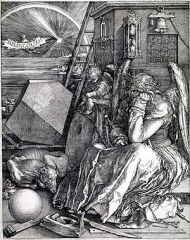
Dürer, Melancholia, engraving, 1514.
|
❦ Unlike other works of Durers that we have seen, its not clear how to read this. Female personification of an angel. Job? Lost in thought. Connect to the discussion of humors- sluggish and somber. Personification of geometry or architecture. Angel holding a compass, strange shapes.. tools of a carpenter/woodworker as well. Member square: occult philosophy. Hourglass/scales: memento mori. Durer's commentary on the artistic process? Writer's block? Frustration that comes along with the gift of being able to create. Possibility of failure as an artist vs. the harmony of St. Jerome's divine inspiration. (the works are contemporary)
|

